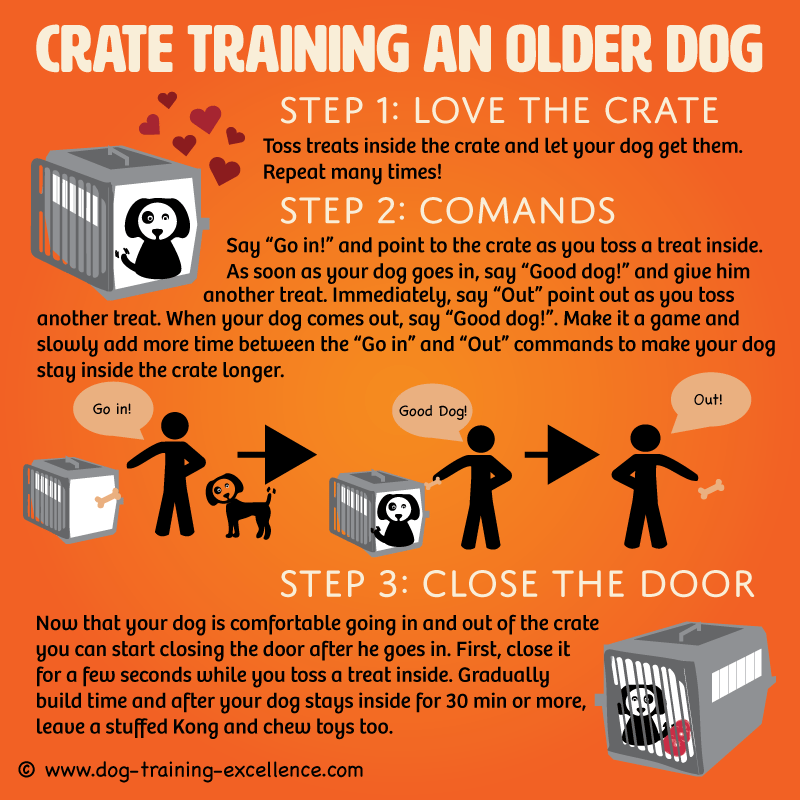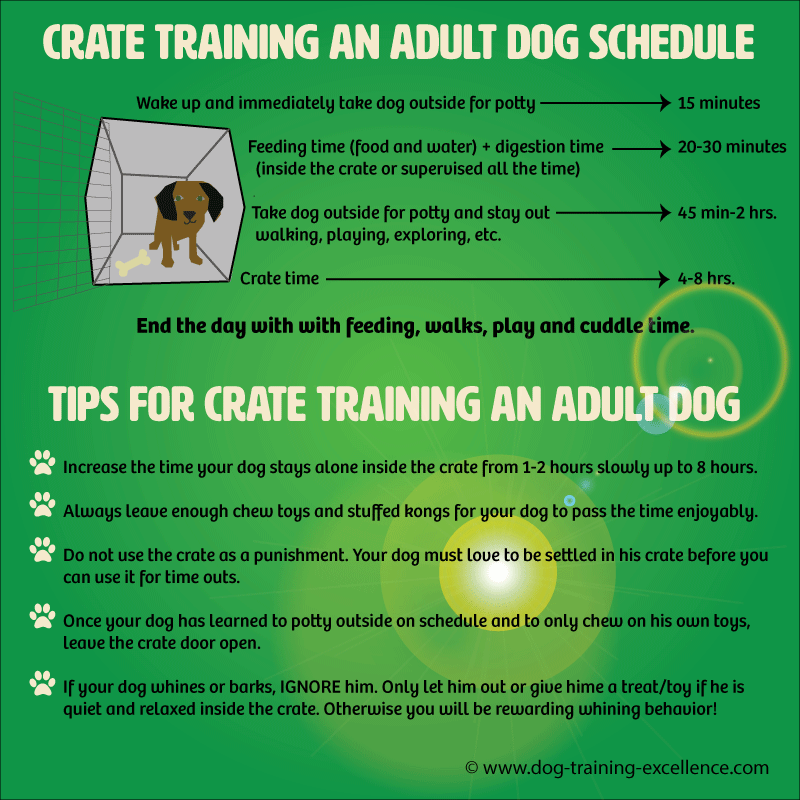I try to write my posts as unbiased as possible and recommend the products I consider to be useful and the best. I use affiliate links, this means that–at no extra cost to you–I can make a commission on a purchase you make after clicking on them. As an Amazon Associate I earn from qualifying purchases.
Crate Training an Older Dog
the Positive way
Crate training an older dog may take a little longer than puppies. This is because young puppies (less than 3-4 month of age) are going through their socialization period, in which they welcome all new experiences. Adult dogs on the other hand, may react with distrust when something new and different happens in their life…like a crate!
That said, crate training adult dogs may be done in 1-2 weeks if you follow the instructions below. The key to successful dog crate training is to go slowly, let your canine friend adjust little by little. Most dogs will actually like to have a safe place to relax, a crate is the equivalent to a wolf’s den.
However, it is important to understand that very long confinement periods of time are not recommended. A dog crate is used as a tool to prevent potty accidents and home destruction, and it is a great way to transport pets as well.
For training purposes, confinement should not exceed more than 6-8 hours. And you must provide plenty of exercise, play and enrichment during the “free” periods of time.
The Best Dog crate for Your Adult Dog
Pick the correct size dog crate
Size is the first thing you need to figure out. Unlike what you may be thinking, cages that are too big are not the best option. A crate should be big enough for your hound to stand up and turn around comfortably, nothing more. If too much extra-space is available, you canine may use part of it as a potty, which is probably what you are trying to prevent.
Measure your dog’s length (from nose to tail), then his height (from ears to toes), add a couple of inches to each measurement and buy the size crate that is closer to those numbers. That’s it!
Choose the best dog crate material
Fabric dog crates are good for travel and spending time in the outdoors because they are easy to fold, store and clean. The drawback is that the dog must still be supervised in case he tries to break out of it. For this reason, I do not recommend a fabric dog crate for training. Wait until your pooch is completely crate trained before getting one of these.
Wire dog crates are the most popular ones because they fold and store easily but the dog has a harder time of escaping or breaking it. These crates are also cheaper than plastic ones and you can find different models with 1 or 2 doors and dividers. If your canine friend needs some quiet, you can put a blanket on top to provide more privacy.
Plastic dog crates are the most sturdy crates, perfect for active chewers. They tend to be more bulky, can’t be folded and take up a lot of storage space. However, these are the preferred crates for airline travel.
Let's face it, crates are uggly. But you can find Furniture dog crates that look better in your home. I would not use one of these for crate training, but only once your dog is fully comfortable inside the crate. You wouldn't want a beautiful piece of crate furniture to get ruined!
These are some of the most popular dog crates for training:
Crate Training an Older Dog Step-by-Step Guide
The best way for crate training an adult dog is to use positive methods. The main reason is that these techniques teach your hound to LOVE the crate, instead of fearing it. Place the crate in a well visited room but out of the walking areas. Dogs like to relax knowing they are close to you. The living room and bedroom are the best places, and in fact some people choose to have two crates, one in each space.
Crate training and older dog Step 1
A first good impression can go a long way!
Once you found the perfect spot, open the gate, call your dog, show him a piece of extremely special and yummy treat and toss it inside the crate. Sit and wait for your dog to go inside the crate and get it. When he does, praise him and give him another treat. Repeat this many times; until your pooch goes in easily and without any reservations. It shouldn’t take more than a day…two at most!
Crate training an older dog Step 2
Introducing commands
It is time to teach your older dog the commands “Go in” and “Out”. This step will make it easier for you to communicate with your canine friend without having to push him inside, which could make him feel uncomfortable. Have a treat in your hand, say “Go in!” then with a pointing gesture towards the inside of the crate, toss a treat inside. Your dog already knows to follow the treat from the previous step. Now, we are teaching him the cue, that is why it is extremely important to say “Go in” BEFORE you toss the treat. With several repetitions, your pooch starts predicting that “Go in” is followed by a treat inside the crate and should start going in after your command and before you toss the treat. You will need many many repetitions!
While you practice, you can teach him “Out” at the same time. Once your dog is inside the crate, say “Out” and toss a treat outside. In the beginning do “Go in” and “Out” one right after the other. As your dog gets more comfortable, start delaying the “Out” to teach him to stay inside the crate for longer periods of time. Build time up to 5-10 minutes, no longer at this point.
Crate training an older dog Step 3
Testing the commands
To check if your hound is learning the cue, say “Go in” with the hand movement pointing to the crate but do NOT toss a treat inside. Wait for up to 10 seconds to see if your canine goes inside anyway. If he does, praise and give him a second treat! And repeat a lot! Do the same with “Out” but when the dog is out use verbal praise only, going out is now the reward.
If your dog doesn’t go inside the crate after 10 seconds, then repeat step 2 a few more times and then try step 3 again.
Crate training an older dog Step 4
When a door closes … good things happen!
It is time to train your adult dog to stay calm and happy inside the crate even when the door closes. The key is always to move slowly. Say “Go in”, when your dog goes in, give him a treat, close the door, drop another treat through the bars and open the door as soon as he is done eating it. So, the door is initially closed for 1-3 seconds, not more!
Crate training an older dog Step 5
Time stretches
Gradually extend the time the door is closed. You can keep on delivering treats through the bars, but try to toss treats at random and slowly extending the time between each treat. The first 5 minutes are the most critical ones, once your dog can stay 5 minutes inside the crate with only one treat through the bars, then you can start walking out of the room. Start by disappearing for a few seconds and gradually increase the time. When your dog is able to stay fro 10 minutes without you on sight, you can start adding time more quickly, jump from 10 to 20 minutes, then to 30, then to 1 hour, etc.
Once your dog stays inside the crate for more than 30 minutes, you must leave a stuffed Kong and/or several chew toys. These special toys and treats MUST disappears as soon as you open the door. To be successful crate training an older dog, it is important that your hound understands that these good treats only happen when he is confined inside the crate, this makes the crate a great place to be in!
A Routine Makes Crate Training an Adult Dog Much Easier
The last step in crate training an older dog is to create a routine around crate time. For example, it i important to take your older dog outside immediately after you open the crate door. Have some play or exercise time while you are out. Feed him, water him and play a little bit more and before going inside the crate again make sure you take him out too!
Crate training an older dog requires patience, that's the important ingredient. If you go slowly enough, your hound will never whine or bark in dispair. If you have questions or would like to tell us your story you can do it here!
Home > Crate Training > Crate Training an Older Dog








New! Comments
Questions? Anecdotes? Tips? Leave me a comment in the box below.